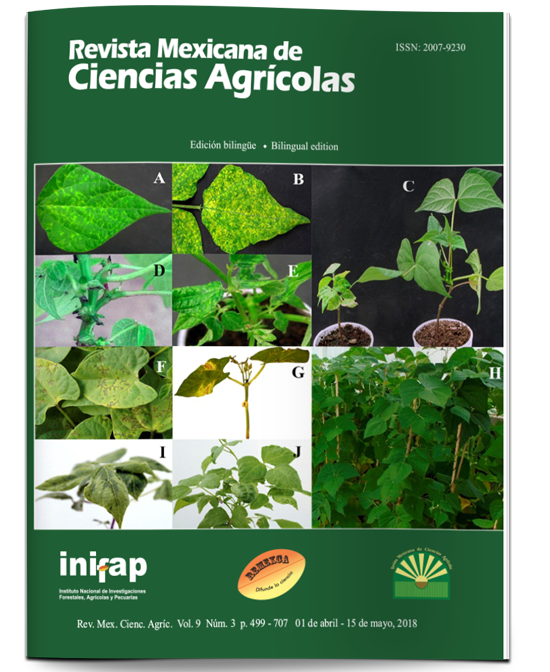Presence of Candidatus Liberibacter solanacearum in Bactericera cockerelli Sulc associated with diseases in tomato, chili and potato
DOI:
https://doi.org/10.29312/remexca.v9i3.267Keywords:
chlorotic buds, tomato permanent, zebra chipAbstract
The “permanent tomato”, “spotted tuber” or “zebra chip” in potato and “chlorotic buds” of chili, are three diseases described in Mexico with coincidental signs of flower abortion, obscuration of vascular tissue at the base of the stem and root of the plants. The association between these diseases and the emerging bacterium Candidatus Liberibacter solanacearum (CLs) as well as the psyllid Bactericera cockerelli as its vector has been mentioned. These diseases, which were initially located in three states of Mexico, have spread to the main Solanaceae producing regions, both in field conditions and in the greenhouse. The objective of the study was to know the presence of CLs associated with diseases that affect the tomato, para and chili crops in Mexico. The bacterium was identified by PCR of the 16S rDNA gene, cloning and sequencing. The alignment of nucleotide sequences was performed with the Clustal W method and the phylogenetic tree was built with the Neighbor-Joining algorithm from distances calculated with the Tajima-Nei method and a Felsenstein index of 1 000 replicas, using the software MEGA version 5.05. A total of 167 samples were analyzed, of which 86 were positive, from 14 states of Mexico. Five nucleotide sequences from Guanajuato, San Luis Potosi and Sinaloa corresponding to tomato, potato and chili, adults and eggs of B. cockerelli were obtained. The analysis of the sequences showed an identity of 99.4% when compared between these and up to 99.8% with GenBank accessions described for CLs in the USA, New Zealand and Canada.
Downloads
Published
How to Cite
Issue
Section
License
The authors who publish in Revista Mexicana de Ciencias Agrícolas accept the following conditions:
In accordance with copyright laws, Revista Mexicana de Ciencias Agrícolas recognizes and respects the authors’ moral right and ownership of property rights which will be transferred to the journal for dissemination in open access. Invariably, all the authors have to sign a letter of transfer of property rights and of originality of the article to Instituto Nacional de Investigaciones Forestales, Agrícolas y Pecuarias (INIFAP) [National Institute of Forestry, Agricultural and Livestock Research]. The author(s) must pay a fee for the reception of articles before proceeding to editorial review.
All the texts published by Revista Mexicana de Ciencias Agrícolas —with no exception— are distributed under a Creative Commons License Attribution-NonCommercial 4.0 International (CC BY-NC 4.0), which allows third parties to use the publication as long as the work’s authorship and its first publication in this journal are mentioned.
The author(s) can enter into independent and additional contractual agreements for the nonexclusive distribution of the version of the article published in Revista Mexicana de Ciencias Agrícolas (for example include it into an institutional repository or publish it in a book) as long as it is clearly and explicitly indicated that the work was published for the first time in Revista Mexicana de Ciencias Agrícolas.
For all the above, the authors shall send the Letter-transfer of Property Rights for the first publication duly filled in and signed by the author(s). This form must be sent as a PDF file to: revista_atm@yahoo.com.mx; cienciasagricola@inifap.gob.mx; remexca2017@gmail.
This work is licensed under a Creative Commons Attribution-Noncommercial 4.0 International license.



